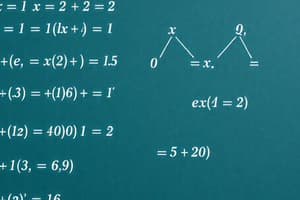Podcast
Questions and Answers
What is the formula for the axis of symmetry of a parabola?
What is the formula for the axis of symmetry of a parabola?
x = -b/2a
What are other names for X-intercepts of a parabola?
What are other names for X-intercepts of a parabola?
- Solutions
- Roots
- Zeroes
- All of the above (correct)
What is the difference between an expression and an equation?
What is the difference between an expression and an equation?
An equation has an =.
What is the quadratic formula?
What is the quadratic formula?
What is a radical?
What is a radical?
How do you know if a parabola will have a maximum or minimum vertex?
How do you know if a parabola will have a maximum or minimum vertex?
What is a rational number?
What is a rational number?
What is a constant?
What is a constant?
What is a coefficient?
What is a coefficient?
What is an x-intercept?
What is an x-intercept?
What is a y-intercept?
What is a y-intercept?
What are different types of transformations?
What are different types of transformations?
What is the exponent rule if you have: (8^3)(8^10)?
What is the exponent rule if you have: (8^3)(8^10)?
With an inequality, what does a closed circle mean?
With an inequality, what does a closed circle mean?
What does 'consecutive integers' mean?
What does 'consecutive integers' mean?
If something is increasing or decreasing by a percent, what kind of relationship is it?
If something is increasing or decreasing by a percent, what kind of relationship is it?
If you have exponential decay (decreasing), how do you know from an equation?
If you have exponential decay (decreasing), how do you know from an equation?
What is any number or variable raised to the power of zero?
What is any number or variable raised to the power of zero?
How do you find the vertex of a parabola?
How do you find the vertex of a parabola?
Solving an inequality is just like solving an equation, except you need to remember...
Solving an inequality is just like solving an equation, except you need to remember...
What type of pattern is in an exponential table?
What type of pattern is in an exponential table?
What does it mean to 'define your variables'?
What does it mean to 'define your variables'?
With an inequality, what does an open circle mean?
With an inequality, what does an open circle mean?
Flashcards are hidden until you start studying
Study Notes
Axis of Symmetry
- Formula: x = -b/2a
X-Intercepts
- Also known as solutions, roots, or zeroes of a parabola
Expressions vs. Equations
- An equation contains an equality sign (=)
Quadratic Formula
- x = (-b ± √(b² - 4ac)) / 2a
Radical Definition
- Represented by a square root symbol, indicating a number's root
Parabola Vertex
- Minimum vertex occurs if coefficient A is positive; maximum if A is negative
Rational Numbers
- Numbers expressible as a ratio, e.g., 2, 1/3, 0.316
Constants
- Numbers that do not contain variables
Coefficients
- Numbers that precede variables in an expression
X-Intercept
- Point where the graph intersects the x-axis, occurring when y = 0
Y-Intercept
- Point where the graph intersects the y-axis, occurring when x = 0
Types of Transformations
- Include translation (shift), reflection (flip), rotation (turn), and dilation (expand/shrink)
Exponent Rule
- For multiplication: (8³)(8¹⁰) results in a base of 8 with exponents added (3 + 10 = 13), yielding 8¹³
Inequality Representation
- Closed circles indicate inclusion of the number (≥ or ≤)
Consecutive Integers
- A sequence of whole numbers in order, e.g., 9, 10
Percent Change
- Indicates an exponential relationship when values increase or decrease by a percentage
Exponential Decay
- Shown by a growth factor of less than one in an equation
Power of Zero
- Any number or variable raised to the power of zero equals 1
Finding the Vertex of a Parabola
- Identify the axis of symmetry and substitute it into the equation to find the corresponding y-value
Solving Inequalities
- Similar to solving equations, but remember to flip the inequality sign when multiplying/dividing by a negative
Exponential Table Patterns
- x values change at a constant rate; y values exhibit a multiplicative pattern
Define Variables
- Clearly state each variable used and its representation, e.g., t represents time
Open Circle in Inequalities
- Indicates that the number is not included in the solution set (< or >)
Studying That Suits You
Use AI to generate personalized quizzes and flashcards to suit your learning preferences.




